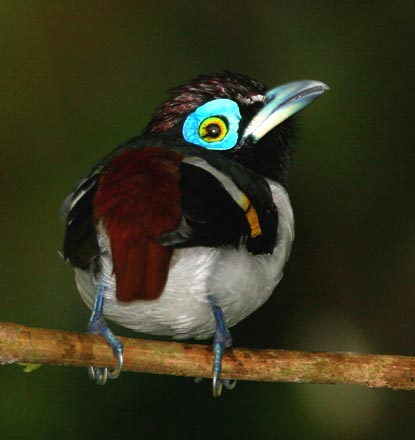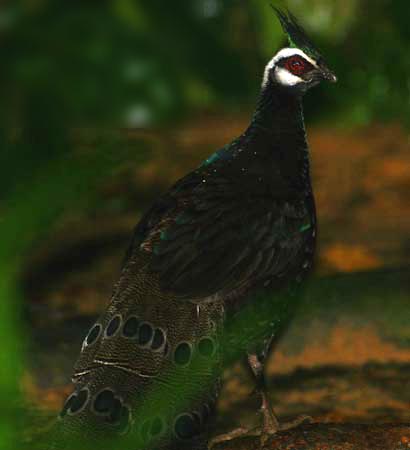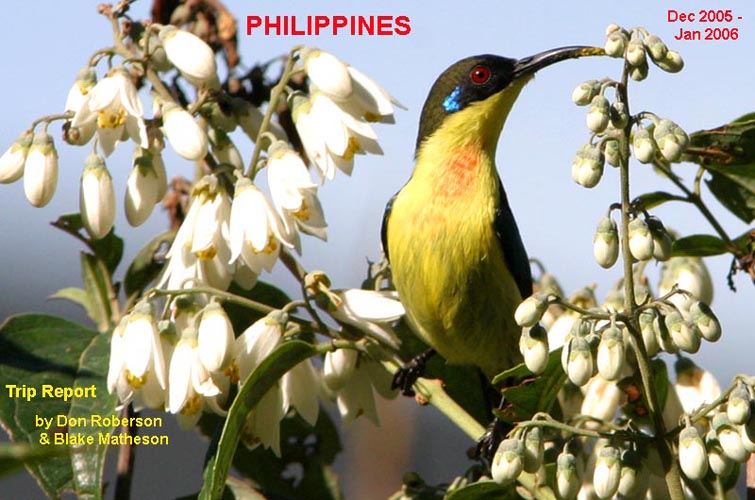
blossoms high on Mt. Polis, Luzon. Photos © D. Roberson
|
||||
The trip was filled with avian highlights, including:
|
||||
|
||||
|
||||
|
 |
It rained every day in December, clearing up only for the 4-day hike to Hamut in early January. Umbrellas and soggy boots were much used every day. Our damp group is shown here on Palawan (L to R; acronyms used below in parentheses): Don Roberson (DR; sitting in a puddle), Blake Matheson (BTM), Anne King (AK), Jon King (JK), Tim Fisher (TF), and Volker Schmidt (VS). |
We visited 13 main sites in this order: LUZON MINDORO NEGROS BOHOL CEBU MINDANAO LUZON |
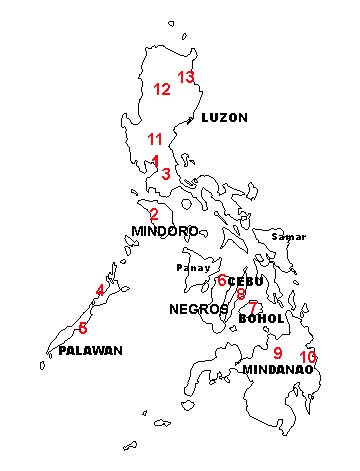 |
Don writes:
| This was the hardest trip I've ever done, even more difficult, I think, than Irian Jaya back in 1994. Not difficult logistically — Tim Fisher's organization, drivers, vans, and local guides were all superb whereas Irian was a disaster logistically — but physically. As a middle-aged couch potato with a desk job, the long hikes up steep, muddy slopes were exhausting. Young turks in excellent shape — like Jon & Anne on our trip — may not have much trouble but this is not a trip for the sedate. The daily grind was at or near my breaking point: up at 4 or 4:30 a.m. every day, and often not reaching that night's lodging until well after dark. During the first four weeks of the trip, there was only one night in which I got my usual 8 hour sleep. This was decidedly a marathon. And the Hamut hike was as difficult as advertised — the preceding 4 weeks were simply training for this ordeal. And yet .... the birding successes were almost unbelievable. Although the Philippine environment has been hacked to shreds since my 1990 visit — and it was on its last legs then — we were able to see, and sometimes even photograph, some of the rarest and most difficult birds in the world. I personally saw 16 of the 'top 20 most wanted' birds that I had picked before we arrived. The trip must be rated a huge success. |
Blake writes:
| A successful expedition to the Philippines was the culmination of a long-held dream. The islands have often been called a “fallen Eden” or “vanishing paradise” and I felt a deep compulsion and urgency to go as soon as time allowed, while the islands’ hundreds of strange and glorious endemic birds still sang and took wing in their ancestral jungles. In hindsight my compulsion and urgency was well-warranted. The continued survival of many of the birds we were fortunate enough to witness — from Philippine Cockatoo to Mindoro Bleeding-Heart and the sublime Great Philippine Eagle — is more in doubt than ever. I sleep easier with the knowledge that whatever happens I have beheld their special splendor. I know what it means to hear Steere’s Pitta call at dawn and see the Palawan Peacock-strut his beaches at Palawan and that comforts me. Physically the trip may have been difficult. But it was not insurmountable and the occasional stresses of sleep deprivation or monsoonal rains are nothing next to a vision of the Celestial Monarch in his home on Mindanao. The unique success of our particular expedition, recording as it did ~150 endemics seen, owes to the culmination of two factors. First and more important was Tim Fisher. Tim, though striding the hill of middle age, manages to tackle any jungle terrain, logistical difficulties, or birding setbacks with the grace, grit, and nonchalance of a battalion of imperial hussars galloping through the jungle. His instinct is uncanny; his ornithological knowledge of the Philippines is unprecedented and will never again be matched; and most importantly his legendary conviviality, generosity, and wit made a tough and at times melancholy journey eminently rewarding. Second was the caliber of our group. Aside from passing or trivial fracases, we got on reasonably well and the troop was composed exclusively of serious, experienced, and talented observers, largely well-braced for the physical and emotional rigors of the journey. It was an important time in my life and as McArthur famously said, "I will return." Perhaps it will be to see the virtually gone Sulu Hornbill in the war-torn jungles of the Sulus, or in the North on Luzon to experience Isabella’s legendary Oriole. Long may they all endure… |
| Certainly Tim Fisher was the key to our successes. Very sadly, Tim passed away after a short illness in late 2010, some five years after our trip. Birding in the Philippines will never be the same again. |
| December is an unusual time for a Philippine birding trip. It is considered to be the end of the rainy season, and most breeding activity occurs March-April. The prime time is usually thought to be February-April, and virtually all public tours are run then. We happened to hit an unusually rainy December. Tim says that most Decembers are relatively dry. Arriving at this time of year had some advantages — some owls and Azure-breasted Pitta were very responsive to tapes — and the days were generally not very hot. Thus the weather was relatively pleasant despite the rain. On Mt. Katanglad, the endemic woodcock was in display every dusk and dawn. The dates had some disadvantages, though. A few species were calling but apparently not yet very territorial. Despite hours of effort on Mt. Polis, for example, neither Long-tailed Ground-Warbler nor Benguet's Brush-Warbler responded to tapes by showing themselves. They were interested but just not that interested. Only one Whiskered Pitta responded to the tape, and we tried a half-dozen or more. In May 2005, a private trip including Rockjumper Tour guides on a busman's holiday, was extremely successful. Usually May is quite wet, but in 2005 it was unseasonably dry, and the group came upon numerous fledged young. So it is possible to visit the Philippines at other times than the traditional "February-March" tour. |
The American Cemetery is a good introduction to some common birds, and tick Blake's first lifers (like White-collared Kingfisher; right), and it is a stake-out for lowland, open-country species (Lowland White-eye, Golden-bellied Gerygone) that will not be easy elsewhere on our itinerary. It was a drizzly afternoon — the first of many more to come — but we flushed a roosting Jungle (Gray) Nightjar for repeated views; a rarity in the Philippines.
(below) view of Lake Lubao at Sablayan penal colony, Mindoro, and the forested hills beyond
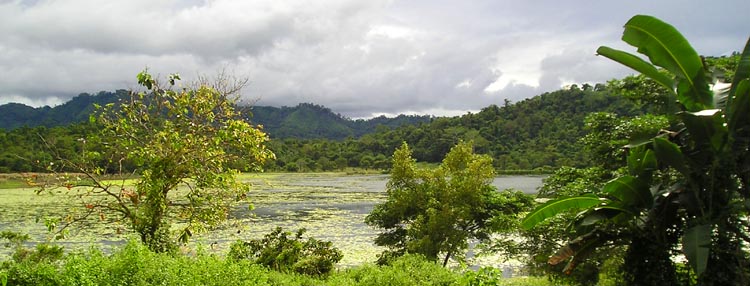
7 Dec:
Up at 3:45am for a 5am flight to San Jose, Mindoro. After procuring
vittles for the next 3 days at a local market, we drove 2.5 hours to
the Sablayan penal colony near Siburan on the west coast of the island.
Here, some of the best remaining lowland forests on Mindoro cover the
hills behind the prison camp. Five Mindoro endemics occur here,
including the endangered Mindoro Bleeding-heart pigeon; the other two
island endemics are montane birds). The afternoon started hot and
sunny; rain would come later. We visited Lake Lubao for waterbirds (Philippine Duck, Wandering Whistling-Duck, White-bellied Sea-Eagle) and the edge of the forest for our first Mindoro endemic (Mindoro Hornbill; digiscoped shot at near right), and fabulous views of Blue-naped Parrot (far right).
That evening we ventured into the forest edge after dark, and taped in a very impressive Mindoro Hawk-Owl (Blake's photo is at the top of this page); it presented a full 'wings-half-spread' threat display to its presumed rival, and I'm pleased to say we left with the local bird winning the battle . . . Mindoro is not often visited by birders because of the lack of accommodations. Our visit here was an add-on to the initial trip plan; an idea proposed by Jon & Anne King. For personal timing reasons the four of us and Tim Fisher did it as a pretrip extension (Volker had to work these extra dates). We slept in sleeping bags on the floor of the local superintendent's house, and brought all our own food and water. Prisoners were our local guides. They wear orange, blue, or green T-shirts, depending on seriousness of their crimes (serious to moderate, respectively), and it was odd at first to hang around with convicted murderers. They proved to be excellent guides and porters, though. This forest has been saved from the loggers so far, presumably because of the prison [Sablayan is just one substation of a much bigger prison system on the island]. Unfortunately, prisoners and locals engage in much trapping in the forest, and bird snares have proved to be a major problem for the endangered bleeding-heart (Brooks et al. 1995).
PHOTOS: All photos on this page are © 2006 Don Roberson, except those © Blake Matheson and so indicated; all rights reserved. Many other shots from this trip are scattered about this web site.
Literature cited:
Brooks, T., G. Dutson, L. Gabutero, and R. Timmins. 1995. Siburan — key area for birds on Mindoro. Oriental Bird Club Bulletin 21: 28-33.
Kennedy, R.S., P.C. Gonzales, E.C. Dickinson, H.C. Miranda, Jr., and T.H. Fisher. 2000. A Guide to the Birds of the Philippines. Oxford Univ. Press, New York.
Wheatley, N. 1996. Where to Watch Birds in Asia. Princeton Univ. Press, Princeton, N.J.
page created 12-16 Jan 2006
|
TO TRIPS PORTAL 2008 |
